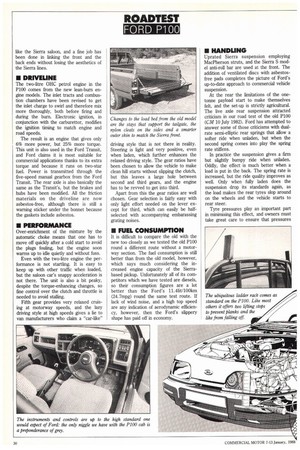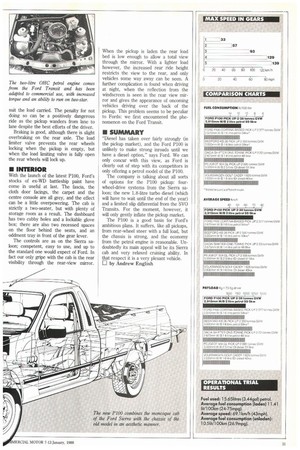PORTUGUESE PICKUP
Page 31

Page 32

Page 33

If you've noticed an error in this article please click here to report it so we can fix it.
Ford's new P100 pickup has been the subject of much speculation over the past year. There are still some unanswered questions, but here is the story so far.
• Ask someone if they know the name P100, and they might falteringly recall a Lucas headlamp that turned night into day. They might even talk of the mighty Packard-engined torpedo-boat stars of the 1945 John Ford movie They Were Expendable (which were actually PT boats). Because like it or not, the name P100, which has adorned the sides of Ford's South African-built, Cortina-based pickup since 1982, still sounds more like a food additive or a rocket to Mars than a commercial vehicle.
The original P100 was a very successful vehicle. By 1983 it had gained a 51% share of the UK specialised pickup market, and newcomers were being tempted into that market by the Ford product. Unfortunately the market moved from beneath the P100's wheels as buyers started to demand all-wheel drive, diesel engines and more power. The Japanese manufac turers were able to meet these demands, and vehicles like the Nissan, Toyota Hi Lux and the Mazda B2000 have become popular in the UK. Several factors contributed to Ford's inability to match the changes in the market which led to the P100's demise in this country.
The problem with specialist vehicles for manufacturers is that they cannot be built on modern mass-production lines with their dedicated robots and machinery. The Port of Elizabeth plant in South Africa was ideal for manufacturing the old P100: its labour-intensive methods suited the pickup's rear chassis and live axle suspended load-bed construction.
When it came to reinvesting in that plant to create a new pickup with a lot of different options, Ford began to feel a bit exposed to criticism from anti-apartheid governments and groups. General Motors had already pulled out of that troubled country, and further links with South Africa were out of the question. Imports of the old 1,600cc petrol-engined P100 ceased at the beginning of last year, and existing dealer stocks have filled in the gap between the old and new models.
• BODYWORK
Ford's Azambuja plant in Portugal has proved ideal for the manufacture of the replacement P100. Labour-intensive production was facilitated by low wage rates, and the plant had been assembling CKD Ford Transits and Escorts for Spain and Portugal. Escort production was stopped and the P100 production line was set up. The labour costs of production for the new pickup are on a par with those of the Port Elizabeth plant, but as there are no shipping costs from South Africa the total variable costs of production have been kept down.
In crude terms the new P100 comprises the Sierra front and the old pickup rear load bed with a redesigned outer skin. Matching the ladder-frame chassis of the rear load bed to the monocoque construction Sierra has proved quite difficult, but by using the American-style side-impact bars and some additional bracing, Ford's engineers have created a continual strengthened chassis between the engine subframe and the ladder rails at the rear.
Evidence of the work involved is found on the floor pan of the cab, where there is a large boxed-in compartment round the extra chassis rails. The load box of the pickup still has the same dimensions as the old model: the floor is ribbed for strength and the wheel arches are square boxes to make cleaning easier.
The load restraint hooks, previously welded cleats, are now made of nylon. Over-centre toggle catches secure the tailgate in position, and it has check straps instead of chains. These changes are clearly the result of some thought by Ford's designers, and they certainly help with the loading of the pickup as well as delaying the onset of corrosion.
From the front the pickup looks just like the Sierra saloon, and a fine job has been done in linking the front and the back ends without losing the aesthetics of the Sierra lines.
• DIUVELINE
The two-litre OHC petrol engine in the P100 comes from the new lean-burn engine models. The inlet tracts and combustion chambers have been revised to get the inlet charge to swirl and therefore mix more thoroughly, both before firing and during the burn. Electronic ignition, in conjunction with the carburettor, modifies the ignition timing to match engine and road speeds.
The result is an engine that gives only 6% more power, but 25% more torque. This unit is also used in the Ford Transit, and Ford claims it is most suitable for commercial applications thanks to its extra torque and because it runs on two-star fuel. Power is transmitted through the five-speed manual gearbox from the Ford Transit. The rear axle is also basically the same as the Transit's, but the brakes and hubs have been modified. All the friction materials on the driveline are now asbestos-free, although there is still a warning sticker under the bonnet because the gaskets include asbestos.
• PERFORMANCE
Over-enrichment of the mixture by the automatic choke means that one has to move off quickly after a cold start to avoid the plugs fouling, but the engine soon warms up to idle quietly and without fuss.
Even with the two-litre engine the performance is not startling. It is easy to keep up with other traffic when loaded, but the saloon car's snappy acceleration is not there. The unit is also a bit peaky, despite the torque-enhancing changes, so fine control over the clutch and throttle is needed to avoid stalling.
Fifth gear provides very relaxed cruising at motorway speeds, and the lazy driving style at high speeds gives a lie to van manufacturers who claim a "car-like" driving style that is not there in reality. Steering is light and very positive, even when laden, which further enhances the relaxed driving style. The gear ratios have been chosen to allow the vehicle to make clean hill starts without slipping the clutch, but this leaves a large hole between second and third gears, and the engine has to be revved to get into third.
Apart from this the gear ratios are well chosen. Gear selection is fairly easy with only light effort needed on the lever except for third, which can easily be halfselected with accompanying embarassing grating noises.
• FUEL CONSUMPTION
It is difficult to compare the old with the new too closely as we tested the old P100 round a different route without a motorway section. The fuel consumption is still better than from the old model, however, which says much considering the increased engine capacity of the Sierrabased pickup. Unfortunately all of its competitors which we have tested are diesels, so their consumption figures are a lot better than the Ford's 11.41it/100km (24.7mpg) round the same test route. If lack of wind noise, and a high top speed are any indication of aerodynamic efficiency, however, then the Ford's slippery shape has paid off in economy.
• HANDLING
Uprated Sierra suspension employing MacPherson struts, and the Sierra S model anti-roll bar are used at the front. The addition of ventilated discs with asbestosfree pads completes the picture of Ford's up-to-date approach to commercial vehicle suspension.
At the rear the limitations of the onetonne payload start to make themselves felt, and the set-up is strictly agricultural. The live axle rear suspension attracted criticism in our road test of the old P100 (CM 10 July 1982). Ford has attempted to answer some of those criticisms with dualrate semi-elliptic rear springs that allow a softer ride when unladen, but when the second spring comes into play the spring rate stiffens.
In practice the suspension gives a firm but slightly bumpy ride when unladen. Oddly, the effect is much better when a load is put in the back. The spring rate is increased, but the ride quality improves as well. Only when fully laden does the suspension drop its standards again, as the load makes the rear tyres slop around on the wheels and the vehicle starts to rear steer.
Tyre pressures play an important part in minimising this effect, and owners must take great care to ensure that pressures suit the load carried. The penalty for not doing so can be a positively dangerous ride as the pickup wanders from lane to lane despite the best efforts of the driver.
Braking is good, although there is slight overbraking on the rear axle. The load limiter valve prevents the rear wheels locking when the pickup is empty, but when the load limiting valve is fully open the rear wheels will lock up.
• INTERIOR
With the launch of the latest P100, Ford's stocks of ex-WI) battleship paint have come in useful at last. The fascia, the cloth door facings, the carpet and the centre console are all grey, and the effect can be a little overpowering. The cab is strictly a two-seater, but with plenty of storage room as a result. The dashboard has two cubby holes and a lockable glove box; there are also two recessed spaces on the floor behind the seats, and an oddment tray in front of the gear lever.
The controls are as on the Sierra saloon; competent, easy to use, and up to the standard one would expect of Ford. In fact our only gripe with the cab is the rear visibility through the rear-view mirror. When the pickup is laden the rear load bed is low enough to allow a total view through the mirror. With a lighter load however, the increased rear ride height restricts the view to the rear, and only vehicles some way away can be seen. A further complication is found when driving at night, when the reflection from the windscreen is seen in the rear view mirror and gives the appearance of oncoming vehicles driving over the back of the pickup. This problem seems to be peculiar to Fords: we first encountered the phenomenon on the Ford Transit.
• SUMMARY
"Diesel has taken over fairly strongly (in the pickup market), and the Ford P100 is unlikely to make strong inroads until we have a diesel option," says Ford. We can only concur with this view, as Ford is clearly out of step with its competitors in only offering a petrol model of the P100.
The company is talking about all sorts of options for the P100 pickup: fourwheel-drive systems from the Sierra saloon; the new 1.8-litre turbo diesel (which will have to wait until the end of the year) and a limited slip differential from the SVO Transits. For the moment, however, it will only gently inflate the pickup market.
The P100 is a good basis for Ford's ambitious plans. It suffers, like all pickups, from rear-wheel steer with a full load, but the chassis is strong, and the economy from the petrol engine is reasonable. Undoubtedly its main appeal will be its Sierra cab and very relaxed cruising ability. In that respect it is a very plesant vehicle. D by Andrew English
































































